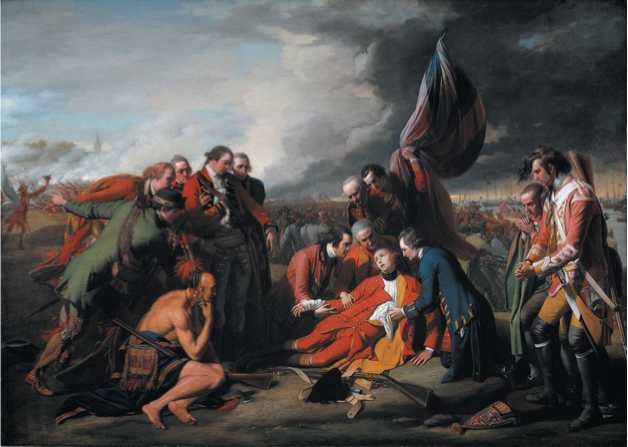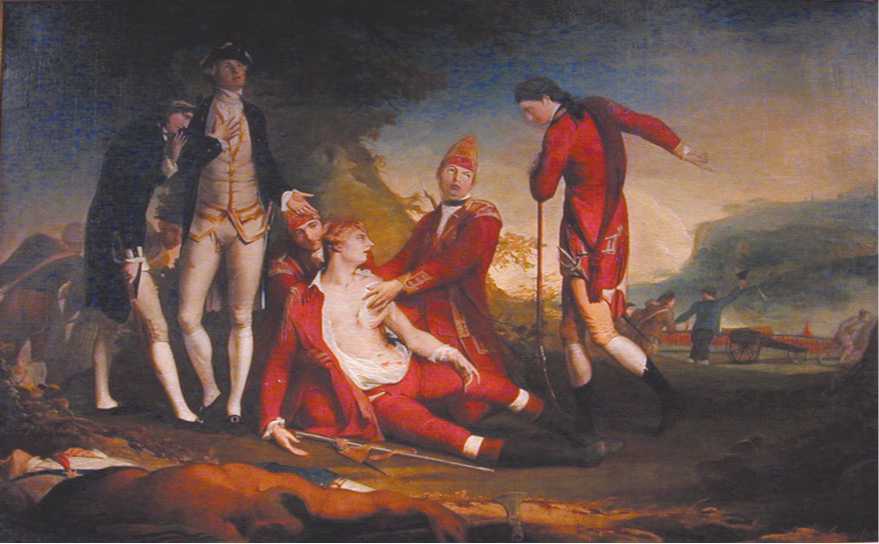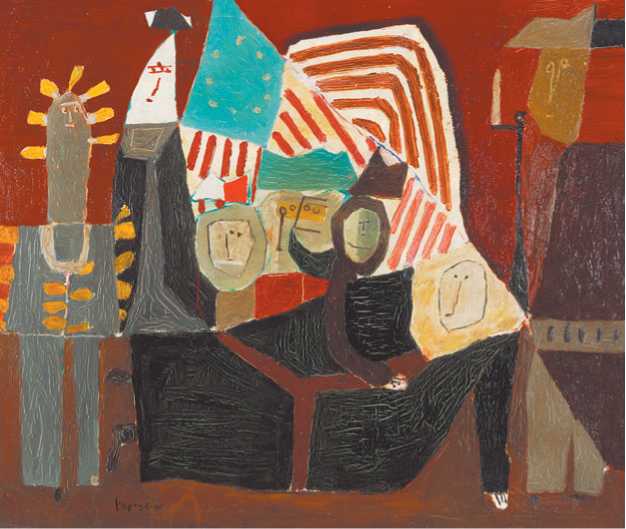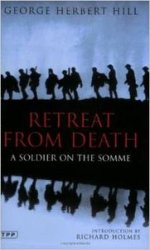
Benjamin West, The Death o'f General Wolfe (1770)
Source: Benjamin West (1738-1820), The Death of General Wolfe, 1770. Oil on canvas, 152.6 X 214.5 cm. Transfer from the Canadian War Memorials, 1921 (Gift of the 2nd Duke of Westminster, England, 1918). Photo © National Gallery of Canada, Ottawa, Ontario.
Benjamin West's The Death of General Wolfe (1770), depicts the British commander's demise at the Battle of Quebec in 1759. Over 300,000 prints of that image were sold, making it arguably the most popular painting of the eighteenth century. Observers were struck by the painting's juxtaposition of the Indian, naked and virile, with the British officer, resplendently uniformed and dying. West's symbolism evoked a new world's confrontation with the old.
The details of the painting, a critic observed at the time, are "so natural that no one would hardly expect them to be otherwise than they appear, and yet not one of them is true in fact."The most serious is that only a handful of officers— and no Indian—witnessed Wolfe's death.
Several years later, artist James Barry resolved to paint the scene more accurately. After researching the circumstances of Wolfe's death, Barry exhibited his version in 1776. Nearly everyone, however, preferred West's symbol-laden fiction to Barry's more dutiful reporting of the event. Today West's painting appears in countless textbooks; Barry's is mostly forgotten.
Two centuries after Wolfe's death, Roy Lichtenstein revisited the subject in his abstract Death of the General (1951). Where West invented characters in order to make a symbolic statement, Lichtenstein arranged colors and shapes to convey meanings of a purely aesthetic character.
Artists have always asserted a right to adjust reality to suit their own purposes. In his Poet/cs, Aristotle, the ancient Greek philosopher, distinguished between the dusty factu-ality of history "a thing that has been"—and the "higher thing" of the storyteller's art—a "kind of thing that might be." Modern novelists and filmmakers, when challenged by historian-critics, invoke this "poetic license."When director Darryl F. Zanuck was criticized for changing history in The Longest Day, a film about World War Il's Normandy invasion, he replied,"There is nothing duller on the screen than being accurate but not dramatic."
Today the line between "art"and "history" has blurred. Television producers routinely enhance the news with reenactments and "docudramas."Historians, though among the first to pounce on historical miscues, often enliven their books with dramatic paintings such as West's fiction.
Whatever its defects in depicting Wolfe's death, West's painting has assumed a prominent place in the history of art. History paintings also provide a vivid reminder that all renderings of the past—in pictures or words—are interpretations.
Source: Michael Kammen, V/sual Shock: A H/story of Art Controvers/es /n Amer/can Culture (2006); Mark C. Carnes, ed., Past Imperfect: H/story According to the Mov/es (1995); Mark C. Carnes, Novel H/story: H/stor/ans and Novel/sts Confront Amer/ca's Past (2001).

James Barry, Death of General Wolfe (1776)

Roy Lichtenstein, Death of the General (1951)
Source: Death of the General by Roy Lichtenstein, 1951 Private Collection. © Estate of Roy Lichtenstein.
Accepted the peace terms offered by a royal commissioner, Sir William Johnson, one of the few whites who understood and sympathized with them. The British government then placed 15 regiments, some
6,000 soldiers, in posts along the entire arc of the frontier, as much to protect the Indians from the settlers as the settlers from the Indians. It proclaimed a new western policy: No settlers were to cross the Appalachian divide. Only licensed traders might do business with the Indians beyond that line. The purchase of Indian land was forbidden. In compensation, three new colonies—Quebec, East Florida, and West Florida—were created, but they were not permitted to set up local assemblies.
This Proclamation of 1763 excited much indignation in America. The frustration of dozens of schemes for land development in the Ohio Valley angered many influential colonists. Colonel Washington referred to the proclamation contemptuously as “a temporary expedient to quiet the minds of Indians,” and he continued to stake out claims to western lands.
Originally the British had intended the proclamation to be temporary. With the passage of time, however, checking westward expansion seemed a good way to save money, prevent trouble with the Indians, and keep the colonies tied closely to the mother country. The proclamation line, the Board of Trade declared, was “necessary for the preservation of the colonies in due subordination.”5 Naturally this attitude caused resentment in America. To close off the West temporarily in order to pacify the Indians made some sense; to keep it closed was like trying to contain a tidal wave.




 World History
World History









